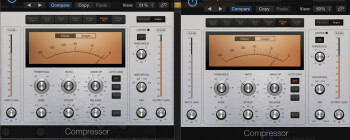Now that we've seen the basic usage of compression when mixing, I'll walk you through a couple of tips and tricks that I'm sure you'll find quite useful. This week we'll look into a technique that might seem very simple at first glance, but it isn't: Serial Compression.
Serial killer
Imagine for a moment that you want to give punch to an instrument while providing it consistency throughout the entire song. As we’ve seen in previous articles, a compressor is a great tool to achieve both of these attributes, but punch and consistency require completely different settings. So, what can you do? You can use two compressors, that’s right, one behind the other, each with the adequate settings. But be careful, as I mentioned in the introduction, it’s not quite as straightforward as it seems.
The first thing to consider is that the order of the compressors is crucial. For example, to get a punchy and consistent sound, the first compressor should be the one aimed at achieving consistency and the second one for getting more punch. Placing them the other way around would be counterproductive, because the consistency settings of the first compressor would be working against the punchy settings of the second. Thus, you’ll have to consider which order works best for you, depending on the goal you have in mind.
It’s important for you to know that the ratios of compressors in series aren’t simply summed, they are multiplied! For example, if the first compressor has a ratio of 4:1 and the second one 6:1, the result won’t be 10:1, but 24:1, which is quite high, to say the least. I’m obviously oversimplifying things to make it easier for you to understand, because, in reality, the compressors don’t have the same attack and release times, the same knee, etc., and they don’t act on the same part of the signal. However, do bear in mind that using several compressors requires you to pay special attention to the ratio settings, otherwise you might find yourself with an excessive compression rate that squashes the life out of your recording.
Another point to take into consideration is that you need to be realistic regarding the use of this technique. In other words, you can’t seriously expect to be able get a really punchy and round sound at the same time. Even using two compressors with adequate settings, you’ll likely end up with a useless mush. So, in the end, you’ll have to make coherent decisions ─ after all, isn’t that what mixing is all about?
I can’t stress enough to be careful not to overdo it with this technique. If you ever use two, or more, compressors in series on every track, I can guarantee you that your mix will disappoint you. There are two things I’ve mentioned before that you should never forget:
- When it comes to mixing, “less is more.”
- Compressors are like antibiotics, don’t overuse them!
See you next week, when we’ll discuss parallel compression.



